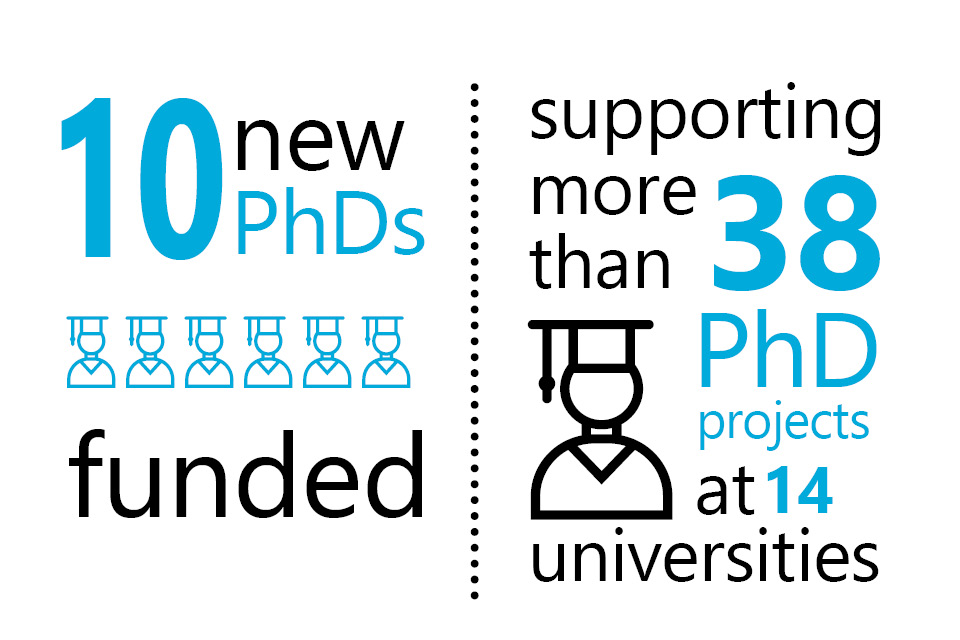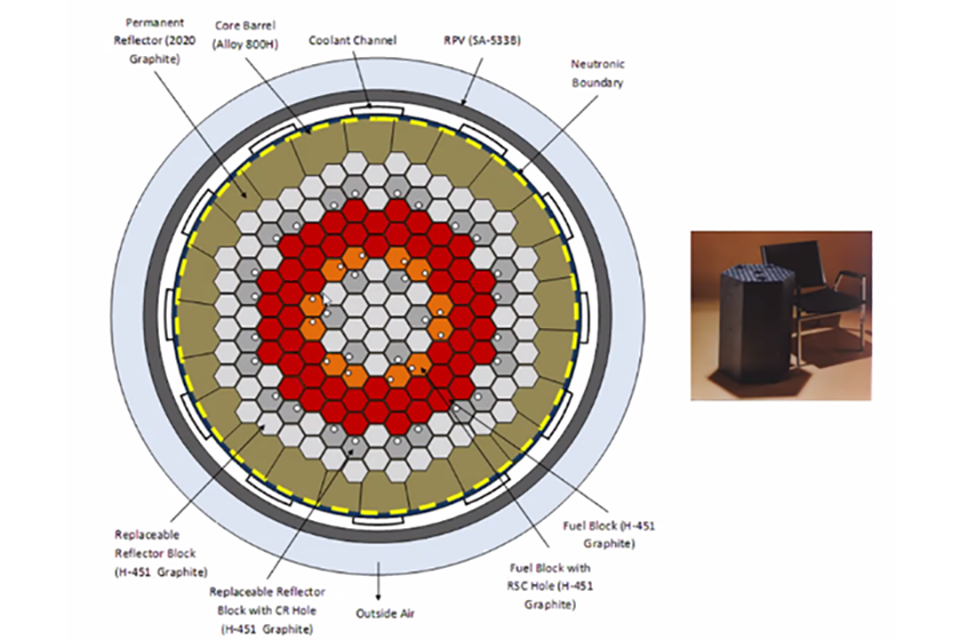NDA Direct Research Portfolio annual report 2021 to 2022
Published 4 January 2024
Introduction
The Nuclear Decommissioning Authority (NDA) is responsible for cleaning up the legacy from the UK’s pioneering post-war nuclear programme.
From the late 1940s onwards, the country’s smartest scientists and engineers led the world with ground-breaking nuclear discoveries. The result was a diverse range of experimental facilities and early nuclear power stations, designed initially for the UK’s defences but later to provide electricity for its citizens.
Their work spanned 17 locations across the UK and included:
- Dozens of prototype reactors
- 11 nuclear power stations
- Scores of research labs
- Fuel-manufacturing and enrichment facilities
- Spent fuel reprocessing plants
Many of the designs were unique, producing radioactive wastes and spent fuel that no-one had ever dealt with before. Structures, pipework, container vessels and land became contaminated and were mostly left for a future generation to clean up.
Many years later, NDA is dismantling this historical legacy, demolishing structures, and preparing sites for future uses. The mission will stretch for another 100-plus years and cost more than £100 billion.
Dealing with such a range of complexities and uncertainties requires fundamental science, innovative thinking, and novel engineering. Progress depends on clearly understanding the problems, finding solutions, and ensuring the cost for taxpayers remains acceptable. Research & Development (R&D) is therefore an essential part of decommissioning programme. The aim is to solve the challenging technical problems more effectively, more efficiently, more safely and, where possible, for less cost.
A total of approximately £96.1 million was spent on R&D during 2021 to 2022 by the NDA group.
The bulk of this forms part of the budget allocated to our Site Licence Companies (SLCs) and subsidiary organisations and is aimed at addressing specific on-site challenges identified during decommissioning activities. The work is carried out by SLCs, the subsidiaries and through contracts awarded to their supply chain.
Separately, NDA also retains a strategic portfolio to commission projects directly, particularly in areas with potential to have an impact across several sites, or to develop our overall strategy. This kind of research may help shape and develop our strategy, encourage early innovation, or maintain key technical skills.
About the DRP
The Direct Research Portfolio (DRP) is a key component of NDA’s R&D programme.
The DRP is made up of projects that:
- Help shape and underpin NDA’s overall Strategy for the UK
- Deliver innovation across our 17 sites
- Develop vital technical expertise for the future
DRP projects are aligned against NDA’s four driving strategic themes:
- Integrated waste management
- Site decommissioning and remediation
- Spent fuel management
- Nuclear materials
DRP projects are commissioned through a series of framework contracts that run for four years using a five-step process. The current contracts, awarded from 2020-2024, involve three frameworks and cover research into the following areas:
- University interactions
- Integrated waste management, site decommissioning and remediation
- Spent fuel and nuclear materials
Twelve successful consortia are involved, six of which are led by SMEs, comprising over 60 organisations ranging from UK universities and research bodies to global corporations and small businesses.
This report outlines several of the projects and key themes funded through the DRP during the financial year 2021 to 2022, for which the total investment was £6.1 million. Some projects are ongoing from earlier contracts, but all have potential for a significant impact across the group.
Further information on NDA’s R&D programme can be found in our 5-year R&D plan.
DRP spend
£6.1 million spent during 2021 to 2022
2021 to 2022 spending breakdown
| Framework Contract | 2021 to 2022 spend |
|---|---|
| University Interactions | £3.0 million |
| Integrated Waste Management & Site Decommissioning and Remediation | £1.0 million |
| Spent Fuel & Nuclear Materials | £2.1 million |


New DRP projects started in 2021 to 2022 by NDA R&D driver
| NDA R&D Driver | Number of new projects (2021 to 2022) |
|---|---|
| Delivering Innovation | 1 |
| Informing Strategy | 4 |
| Maintaining Skills | 11 |
Note: Some DRP research projects have multiple drivers
University Interactions
University Interactions Framework Contractors
| Lead Organisation | Consortia |
|---|---|
| NNL | Frazer-Nash Consulting Ltd |
| Arup and National Physical Laboratory |
New PhDs funded in 2021 to 2022
| PhD Title | University | R&D Driver |
|---|---|---|
| Evaluating Nuclear Heritage: Developing New and Practical Approaches to a Complex Industrial Landscape | University of York | Maintaining Skills |
| AI-Embedded Robotic Multi-Sensory Characterisation and Decontamination ‘Toolkit’ | University of Bristol | Maintaining Skills |
| Compact Beta/Gamma Detector Systems for Magnox Core Characterisation | University of Glasgow | Maintaining Skills |
| The Management of Spent Oxide Fuel: Detecting the Onset of Cladding Corrosion Under Irradiated Fuel Storage Pond Conditions | Lancaster University | Maintaining Skills |
| Decontamination of Carbonaceous Nuclear Waste Streams for Segregation and Possible Re-use | University of Manchester | Maintaining Skills |
| Using Experimental Actinide Chemistry to Solve Technical Challenges in Spent Fuel and Nuclear Material Management within the NDA Group. | University of Glasgow | Maintaining Skills |
| Semiconductor Detector Based In-situ Beta Detection at Nuclear Decommissioning Sites | University of Glasgow | Maintaining Skills |
| Thermal Treatment of NDA Asbestos Wastes: Underpinning Science and Disposability Toolbox Development | Sheffield Hallam University | Maintaining Skills |
| Enhanced Nuclear Fuel Monitoring with Beta-Gamma Coincidence Detector System | University of Surrey | Maintaining Skills |
| Evaluating the Performance of Plutonium Immobilisation Matrices under Geological Disposal Conditions | University of Huddersfield | Maintaining Skills |
During the financial year 2021 to 2022 we:
- funded 10 new PhD’s
- awarded 8 PhD’s
- retained 75% of PhD graduates in decommissioning workforce
Case Study: Mental Health Awareness Sessions for Students
Challenge: Undertaking a PhD research project can be difficult at the best of times, but during the pandemic we saw a significant increase in the number of our students who were being adversely impacted by stress. The situation was being exacerbated by the significant reduction in contact time with their academic research groups and peers as a result of the imposed lockdown periods. Furthermore, the support being offered by their host institutions varied significantly in terms of availability and quality, so we organised some mental health awareness and resilience workshops for the students to be delivered by our own Mental Wellbeing providers Thrive.
Solution: Over the course of 4 months, we delivered 3 online workshops plus a ½ day in-person session with the mental health experts, giving the students an opportunity to learn about how to recognise signs of stress in themselves and others, guidance on how to approach conversations around mental wellbeing, techniques for improving their resilience and information on how to access professional support if required.
Benefit: The feedback we got from the students who took part was overwhelmingly positive. They came away feeling reassured that they weren’t alone in experiencing mental health challenges within their peer group, better armed to deal with those challenges, and crucially more willing to talk about their own issues with others and to try to help others in whom they recognised signs of stress.
Integrated Waste Management(IWM) and Site Decommissioning and Remediation(SDR)
IMW and SDR Framework Contractors
| Lead Organisation | Consortia |
|---|---|
| DBD | AECOM, Amentum, Westinghouse (WEC), United Kingdom Atomic Energy Authority (UKAEA) and University of Sheffield including Nuclear AMRC (UoS) |
| Eden Nuclear and Environment Ltd | Cyclife EDF, Gardiner & Theobald, Golder Associates (UK) Ltd, Hydrock Consultants Ltd, Integrated Decision Management (IDM) and University of Bristol and WSP UK Ltd |
| Galson Sciences Ltd | National Nuclear Laboratory, Frazer-Nash Consulting Ltd, Amphos 21, Lucideon, Mott MacDonald Ltd, Resolve Robotics Ltd, VTT Technical Research Centre of Finland, Orano, Veolia and Universities of Bristol, Lancaster and Sheffield |
| Jacobs | Andra, CL:AIRE, British Geographical Survey, NPL, AFRY, Arup, Brenk Systemplanung, Costain, Thornton Thomasetti, Urenco, Croft, Cogentus, Decision Analysis Services, Longenecker and Associates, MCM, Imperial College London and Universities of Birmingham, Bristol and Manchester |
| NSG Environmental Ltd | Abbott Risk Consulting, KDC, Quintessa Ltd, RPS Consulting Services Ltd, SOCOTEC UK Ltd, The University of Sheffield including Nuclear AMRC (UoS) and Veolia Nuclear Solutions, Lucideon, Mirion Technologies, STERIS and The University of Manchester |
| Nuvia | TÜV UK (TÜV NORD), CIEMAT, Createc, Cognition Land and Water, Lucideon, NucAdvisor and Empresarios Agrupados |
New IWM and SDR projects started in 2021 to 2022
| Project Name | Lead Organisation | R&D Driver |
|---|---|---|
| A Holistic Review of R&D and Application of Lower-Carbon Cements and Concretes Applicable to Construction | Jacobs | Informing Strategy Delivering Innovation |
Case Study: A Holistic Review of R&D and Application of Lower-Carbon Cements and Concretes Applicable to Construction
Challenge: To facilitate decommissioning the NDA will have to build supporting facilities such as waste storage, geological disposal or near surface disposal, as well as its potential use in the construction of waste packages. The need to utilise alternative concretes to meet net‑zero emission policies is already being practiced across the NDA estate, by incorporating ground granulated blast-furnace slag (GGBS) or pulverised fuel ash, with standard practice in the decommissioning industry being >70% GGBS. However, optimisation and innovative concrete solutions will be necessary to mitigate the risk of GGBS availability.
Solution: A landscape report and literature review of the current practices and innovations within lower carbon concretes.
Benefits: Decision makers are informed with the appropriate knowledge to enable appropriately targeted investment and/or knowledge transfer to ultimately reduce the cost and environmental impact from cement and concrete across the estate.
R&D Driver:
- Informing Strategy
- Delivering Innovation
Research Organisations:
- Jacobs
- Costain
- Arup
This project aligns to the Sustainability element of the NDA Strategy 2021 Critical Enablers and the role of the NDA in promoting net zero greenhouse gas emissions and our Integrated Waste Management research themes. As a major contributor to greenhouse gas emission across the estate, cement and concrete are key elements of this strategy. The project reviewed current sources of information and interviewed key stakeholders to identify and summarise current practice in the use of concrete and the status of research into lower carbon cements and concrete in construction materials in the NDA Group.
A carbon footprint assessment of the identified cement/concrete and their alternatives was undertaken. The project also assessed if alternatives (e.g., secondary cementitious materials and total cement replacements like alkali activated materials and geopolymers) would be feasible alternatives for use within the nuclear industry. The analysis presented in the reports identifies key knowledge gaps, areas for growth and outlined actionable recommendations on future research opportunities and innovative practices. This will allow the NDA to drive net zero innovation in the use of concrete for construction and further.
Early career staff worked in collaboration with experienced subject matter experts in the delivery of the project. This allowed new technical competencies and skills to be developed by the early career team members, particularly in the understanding of current cement and lower carbon concrete markets and the requirement and feasibility to integrate lower carbon concretes in key applications. Project management skills were also developed by the early career staff by assisting more experienced project managers. Supporting staff development is one part of ensuring the NDA and its supply chain are developing future subject matter experts to address the nuclear skills shortage.
Spent Fuel(SF) and Nuclear Materials(NM)
SF and NM Framework Contractors
| Lead Organisation | Consortia |
|---|---|
| DBD | AECOM, Amentum, Westinghouse (WEC), United Kingdom Atomic Energy Authority (UKAEA) and University of Sheffield including Nuclear AMRC (UoS) |
| Eden Nuclear and Environment Ltd | Integrated Decision Management (IDM), NSG-Environmental Ltd, Nuclear-21, TÜV UK (TÜV NORD) and University of Bristol |
| Jacobs | Andra, Pacific Northwest National Laboratory, British Geographical Survey, NPL, Arup, Brenk Systemplanung, Thornton Thomasetti, Urenco, Studsvik, Croft, StrataG, GRI Ltd, Decision Analysis Services, Longenecker and Associates, Thor Energy, Loughborough Materials, Integrity Corrosion Consulting, Gary Was Consulting, Nigel Donaldson Consulting, Imperial College London and Universities of Birmingham, Bristol, Cambridge, Manchester, Oxford and Sheffield |
| NNL | Frazer-Nash Consultancy Ltd, Galson Sciences Ltd and GRI Ltd |
| Orano | EDF Energy, Cavendish Nuclear, Lucideon, Galson Sciences Ltd, University of Manchester and University of Sheffield |
New SF and NM projects started in 2021 to 2022
| Project Name | Lead Organisation | R&D Driver |
|---|---|---|
| New Technology for MOX Fuel Processes Including Uranium Active Trials of Flash Sintering | NNL | Informing Strategy |
| AGR Technical Forum | NNL | Maintaining Skill |
| Assessment of the Potential of High Temperature Gas Reactors for a Plutonium Disposition Programme | Jacobs | Informing Strategy |
| Investigation of Options for Replacement of NDA SED Scores Including the Ability to Include Security Considerations | Eden | Informing Strategy |
Case Study: Assessment of the Potential of High Temperature Gas Reactors for a Plutonium Disposition Programme
Challenge: The NDA continues to investigate options for the disposition of the UK’s plutonium inventory. The focus of this has been options which are capable of deployment in the short term, such as LWR MOX, Disposal MOX and zirconolite waste forms, however limited assessments of advanced systems such as fast spectrum reactors have been carried out. The Department for Energy Security and Net Zero (formerly BEIS) have selected High Temperature Gas (Cooled) Reactor (HTGR) as one of the systems for further consideration in the Advanced Modular Reactors (AMR) programme. As such the NDA wished to inform its own position on whether this reactor system and fuel cycle offers any advantages or disadvantages in support of a re-use option for the disposition of the UK’s civil plutonium inventory compared to a once through LWR fuel cycle.
Solution: This work was competed and won by Jacobs who carried out the project to assess the HTGR as a potential route for disposition of the UK’s civil plutonium inventory.
Benefits: This informs the NDA of how potential for new reactor designs could influence broader NDA strategy and allows us to assess how the introduction of new reactor designs to the UK can offer alternate approaches to plutonium disposition.
R&D Driver:
- Informing Strategy
Research Organisations:
- Jacobs
Jacobs carried out a high-level investigation into the application of high temperature gas reactors (HTGRs) for the disposition of the UK’s stockpile of separated plutonium. Through a review of past and recent literature, the report presents the current status of the following topics with an emphasis on plutonium-based fuels worldwide HTGR experience, fuel manufacturing, spent fuel storage and disposal. Using these reviews as a basis, reactor physics analysis was undertaken to assess the safety and operational characteristics of a representative plutonium burning HTGR. This analysis was then used to inform fuel cycle studies which assess the fabrication and disposal requirements of various fleet configurations, along with the capacity for plutonium disposition and electricity generation. A representative MOX based LWR fuel cycle scenario study was also undertaken to provide a comparison to the HTGR scenario. Using information from these studies a roadmap was presented highlighting key areas of developments required as well as associated timescale for the realisation of a HTGR fleet for plutonium disposal. It is concluded that using these assumptions it is likely to be at least the early 2050s before any significant HTGR fleet could be deployed.
This work found that the processes used to manufacture uranium bearing HTGR fuels were directly applicable to plutonium bearing fuels, though a modern fuel qualification programme would be required to validate the performance of plutonium bearing HTGR fuel.
Jacobs used the MHTGR-350 reactor as a baseline design to undertake reactor physics modelling. As well as providing the required information for the fuel cycle studies, this initial study suggests that acceptable neutronic behaviour and reactor control can be achieved with HTGR core configurations ranging from 20% to 100% plutonium fuel, although more detailed modelling is needed for confirm this.

Figure 1: Prismatic MHTGR-350 HTGR reactor overview
A range of comparisons are drawn between MOX based HTGR and LWR fuel cycles throughout this work. For HTGRs burning a representative 20% plutonium MOX, it would take 12 MHTGR-350 reactors to irradiate the whole plutonium stockpile within the lifetime of the fleet. In comparison, a fleet of a 4 EPRs would be required assuming a standard 30% MOX loading in the core. In conclusion this work combined the expert analysis of all stages of a HTGR fuel cycle with insight into fleet deployment options gained through modelling, to inform the NDA about the potential use of HTGRs for the disposition of the UK civil plutonium stockpile.

